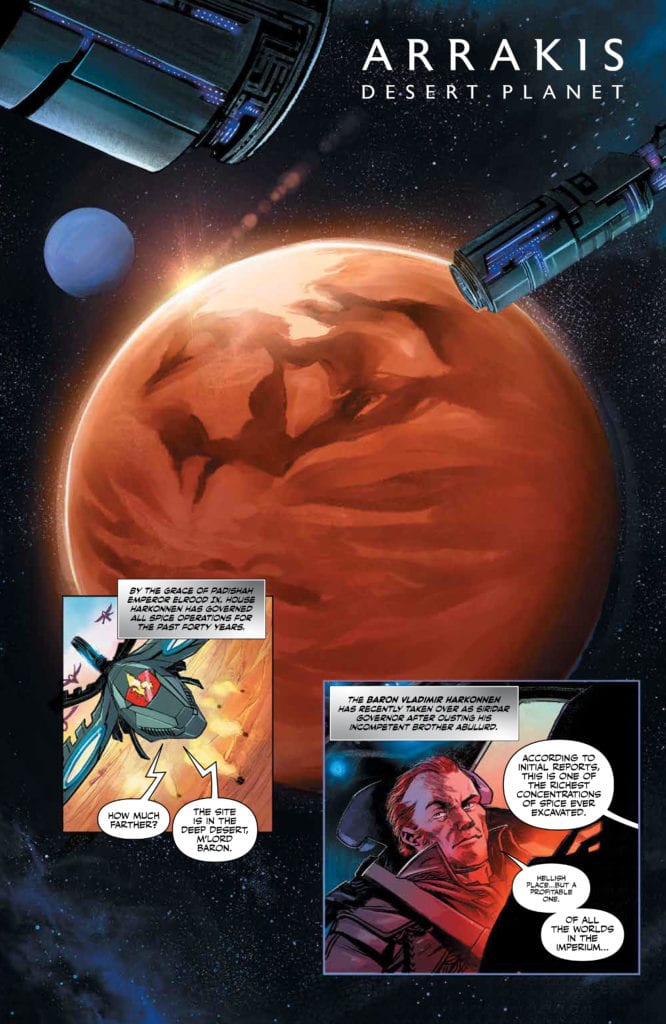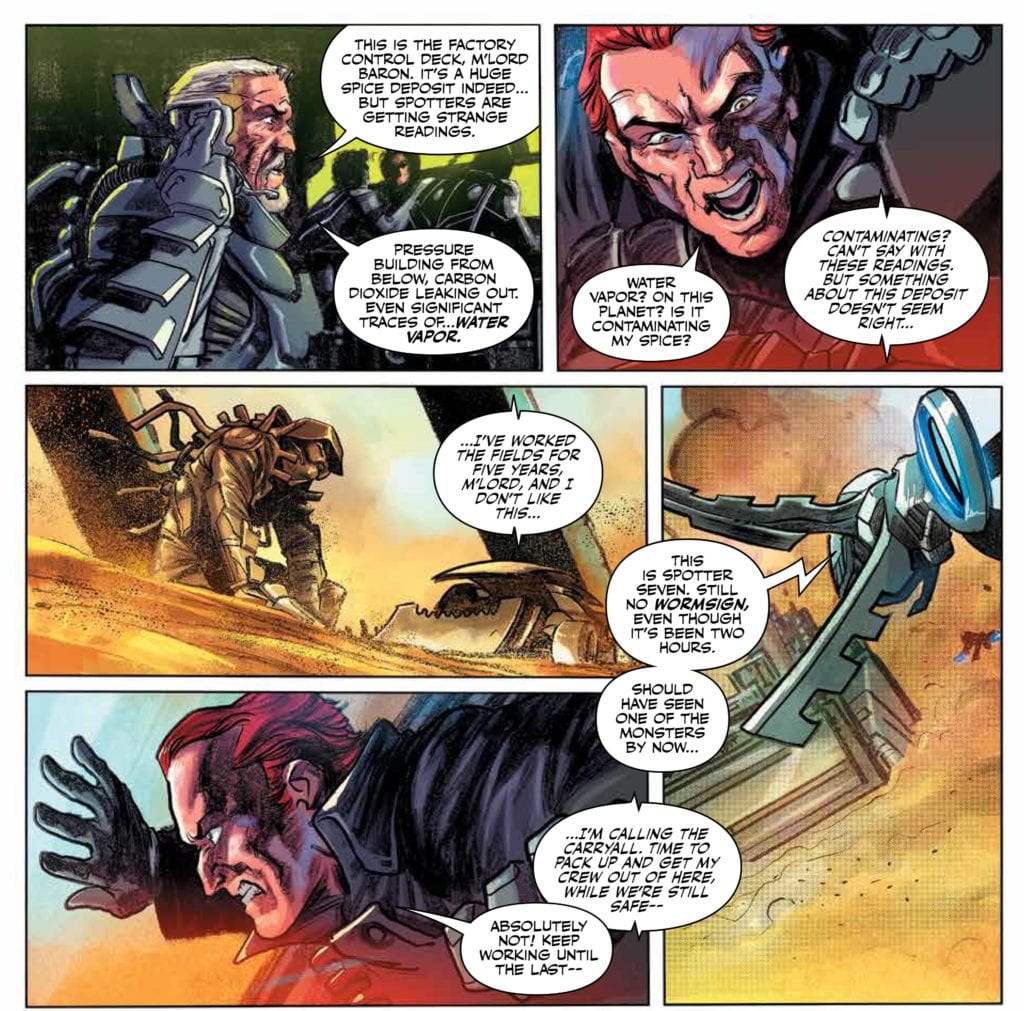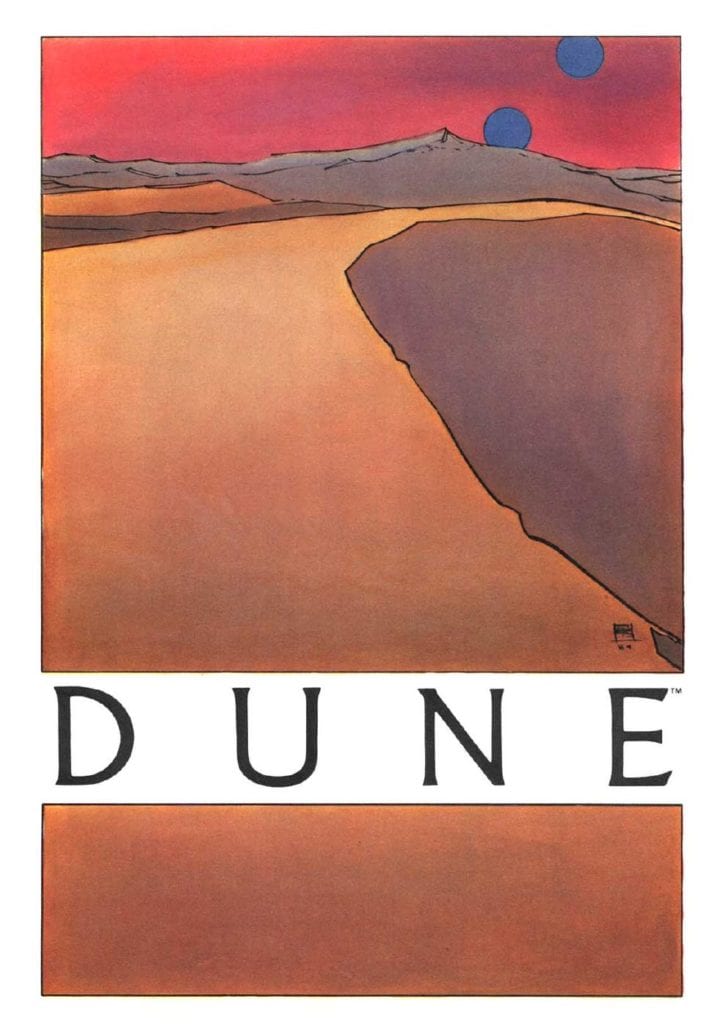Boom! Studios would like to welcome you to Arrakis, also known as Dune, the political centre of the universe and home to the Spice. With a new movie on the horizon, and trailers currently wowing audiences across the globe, there’s no better time for comics to return to the sprawling landscape created by Frank Herbert in 1965. A world of wonder, intrigue, and danger awaits anyone who visits the barren landscape.
Dune House Atreides is a prequel to the original novel and was written by Brian Herbert and Kevin J Anderson, who have adapted it for this comic release. Expanding on the world created by Frank Herbert, House Atreides builds on the family history of the main characters while introducing a new, mostly reprehensible, cast. The worlds and the people are brought to life by artists Dev Pramanik and Alex Guimaraes.
At this point Dune House Atreides, the novel, is 21 years old. Since it was released Brian Herbert and Kevin J Anderson have worked on numerous prequels, sequels, and whatever the word is for books set at the same time as the original. Their engagement with the Dune universe is all encompassing, basing so much of their novels on the notes made by Frank Herbert before he passed away. In short, the writers know this world inside and out, and the depth of their knowledge is woven into the script of this comic.

A Quick Anecdote.
At a recent, well organised and socially distanced screening of Akira, I sat in awe as the trailer for the new Dune movie was played out in front of us. Behind me a young lad turned to his friend and said “the book is really difficult to get into”. I had an urge to turn around and disagree with him: the novel is a gorgeous, poetic narrative full of the most amazing imagery and character. Then I remembered that not everyone felt like that, not everyone enjoyed the hyper-political, religious dystopia that Frank Herbert had painstakingly created. So I did the right thing, I kept my opinions to myself and watched 4K Japanese madness.
The point is that Dune, like many such stories, has an ardent following of fans who are as engrossed in the novels as the writers are but also, the mysteries of Arrakis remain just that to a large number of people who try to engage with the novels. You cannot deny that Herbert’s original is a masterpiece of science-fiction but it’s not for everyone and the following series of books become less appealing if you can’t engage with the first.
This adaptation of Dune House Atreides is no different. I feel as though I should write two reviews, one for fans of the series and one for those coming to this fresh, possibly in anticipation of the new movie. Each will have a different experience with this comic.

The Story and The Art
Set 35 years before the events of the Dune, House Atreides unravels the histories of the older generation from the original. It contains references from the past and the future, highlighting the vast universe that Herbert and Anderson have helped create over the last 21 years through their 13 novels. House Atreides was their first collaboration but this adaptation of it shows two writers comfortable within their world. The characters are vivid and enter the story fully formed, their histories seeping through their speech.
Much of the visual world building comes from the art, with Pramanik and Guimaraes interpreting the unbelievable vistas to produce awe inspiring, alien worlds for the complex characters to inhabit. The changing color palettes signify the different planets and their environments, not just physical but also political. Arrakis is a wasteland, harsh and dangerous, but it is also the most important planet in the universe. There is a contrast between the uncomfortable reds and oranges burning across the page and the allure of the gold representing the wealth within the planet. Danger, risk, reward: this concept is plain within the artwork.
The more complex political intrigues are represented through the interactions between the characters. On occasions this appears clumsy upon the page, with the characters over acting their parts. The scene where the Planetologist Kynes meets with the Emperor is a litany of over exaggerated facial expressions that could be read as character building but is too comical to be taken seriously.

The Old and The New
The artwork for Dune House Atreides will be the biggest divider between fans and non-fans. Coming at the comic with no prior knowledge will allow the reader to discover the world through Pramanik and Guimaraes’ eyes, undisturbed by years of expectation from reading the novels. If, like me, you are a big fan of all things Dune, the artwork will be more problematic. The style adopted here reminds me of Claudio Sanchez’s The Amory Wars; which is a classic comic book style. This works for telling the story and the panel design leads you through some difficult to follow conversations.
Of course a large part of the design is the placement of the speech balloons by the talented Ed Dukeshire. The flow of the narrative is almost 100% dictated by the flow of the speech. Dukeshire has a great skill for staging conversations and emphasising as little as possible while making the greatest impact. He even manages to give the inner monologues a unique look and feel so that the reader immediately associates the dislocated speech with a particular character. The inner monologues, which are synonymous with Dune, are underused in this comic but Dukeshire proves within a few instances that they could be a major feature of the comic.
The main problem is not with what is in the comic but what could have been. Dune is an exceptional world, with exceptional stories, and it is a shame that the direction the comic has taken is classic in style. A quick look at the work Bill Sienkiewicz did on the original movie adaption (see below) shows you what the world of Dune could look like. At a time when the comic industry is branching out in different directions and the ‘superhero’ format of comics is not seen as the only way to do things, it is a shame that more experimentation didn’t go into this comic. Sienkiewicz created vast spaces of empty space that pulled the reader in before bombarding them with intense characters and relationships. That sense of awe, of being lost in a world barely imaginable, is missing from House Atreides. From a fan point of view, I wanted more visually than this comic offers.

Conclusion
Dune House Atreides is a magnificent introduction to the web like narrative of the Dune saga and a great first issue for a new series. It has everything that a new reader would want from a new sprawling science-fiction comic: action, adventure, intrigue, a host of references that have no grounding in the story but are waiting to be revealed or discovered at a later time. This will also be an interesting re-read after seeing the movie, as you can revisit the characters and relate them to their future actions.
It’s main drawback comes from a personal point of view, but is one that I believe will be felt by a number of Dune fans: it is too safe. The artwork doesn’t push the boundaries far enough or challenge the reader in the way the novels do. The complex character relationships feed off the environment and unfortunately that intensity is missing from these pages. The technical skills of the artist and colorist are not in doubt but, for me, a more experimental approach to the visuals would have suited this world better, and Dukeshire’s lettering would still have worked as a guide through the narrative.
I enjoyed this comic and most people who read it will also enjoy it. Unfortunately my expectations were higher, I wanted to be in awe of this and be challenged on every page. That did not happen for me but maybe it will for you.

